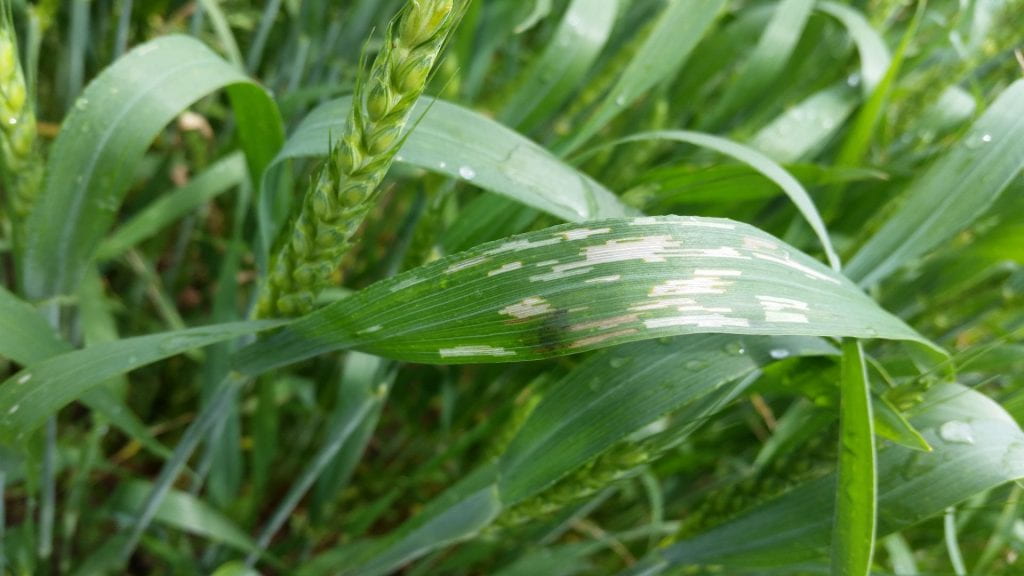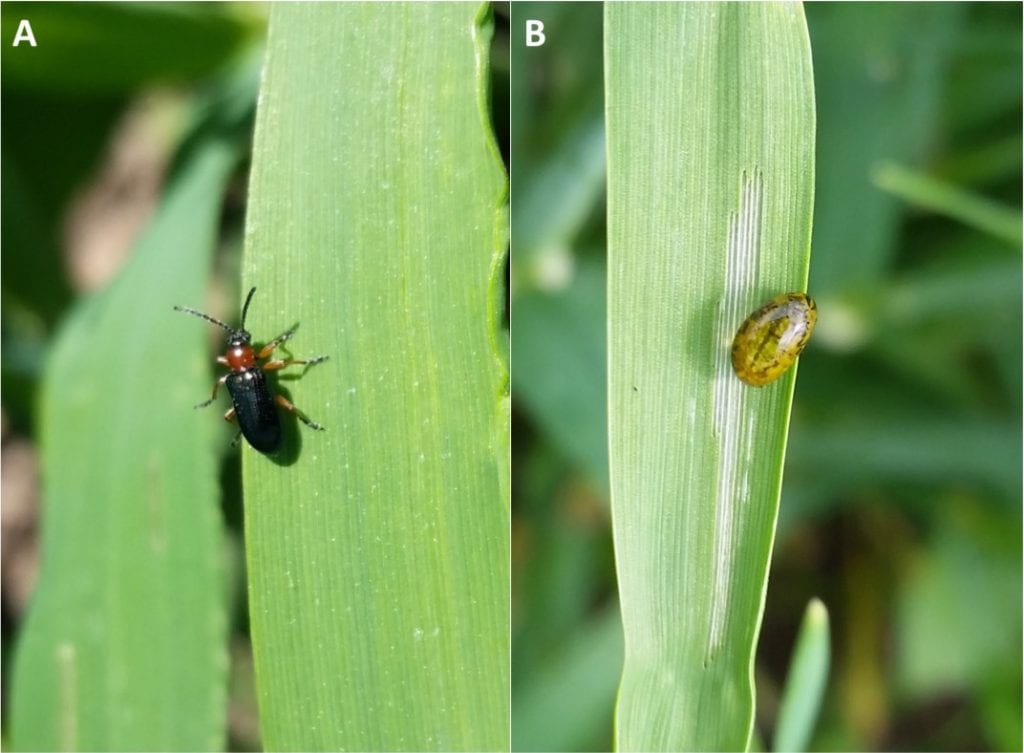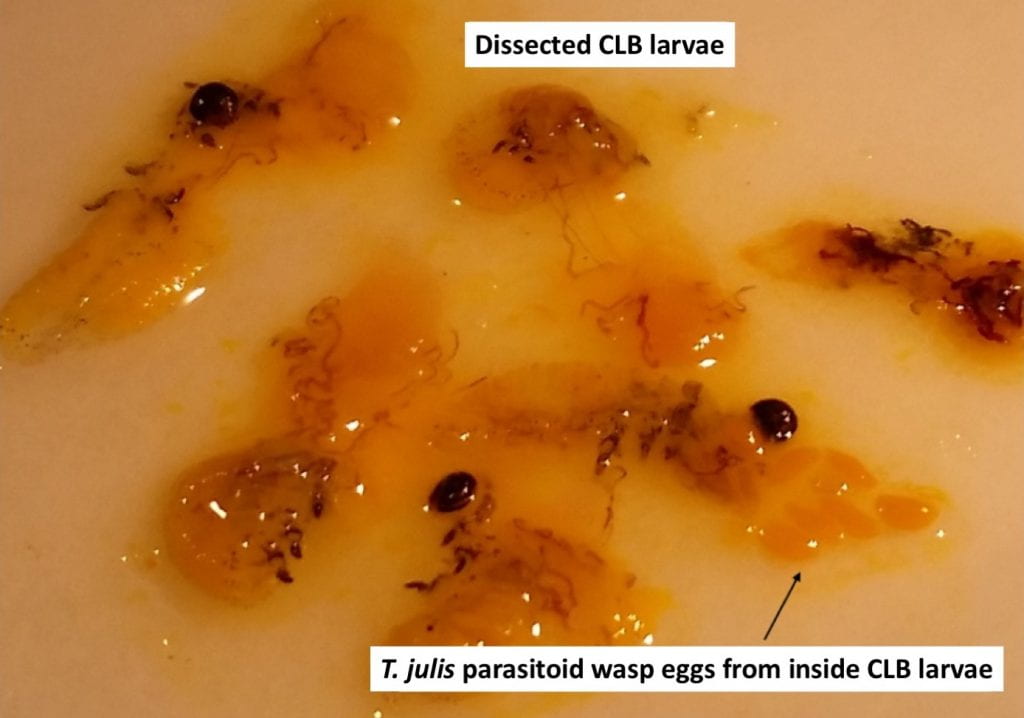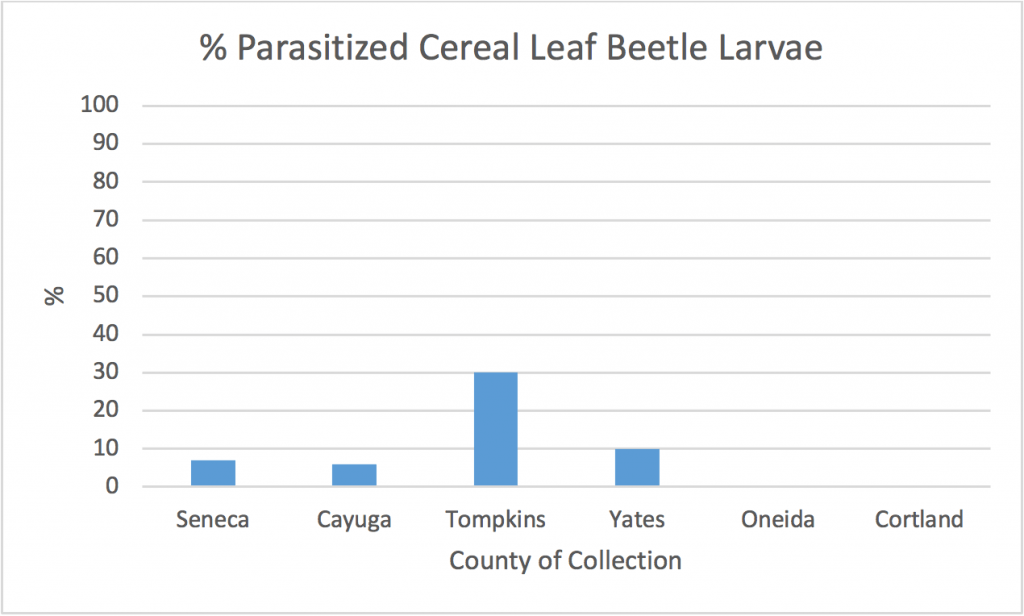This month’s post is about a project being led by Jaime Cummings, the Field Crops and Livestock IPM Coordinator at NYS IPM. The goal is to improve biological control of the cereal leaf beetle, a pest of small grains. Before we tell you about the biocontrol project, you’ll need some background information on this pest and the other management options available. You can use the following links to navigate to each section of this post:
Cereal leaf beetles and damage they cause
Scouting for cereal leaf beetle and deciding when to spray
Biocontrol of cereal leaf beetle
Our project: Improving biocontrol of cereal leaf beetle

Cereal leaf beetles and the damage they cause
The cereal leaf beetle (CLB), Oulema melanopus, can be a significant pest of winter and spring small grains production in NY, especially in parts of western NY. This invasive species was first detected in Michigan in 1962, and has since become established in many grain producing states in the US, despite quarantine and pesticide eradication efforts in the 1960’s and 1970’s.

You may be familiar with this pest either in the larval or beetle stage (Fig. 1). CLB has one or two generations per growing season, and the adults overwinter in hedgerows, woods or field margins. We usually start seeing the adults move into small grains fields in April or May to lay eggs which develop into the damaging larvae. The larger the larvae get, the more damage they inflict on the crop. After about two weeks of feeding, the larvae drop to the ground and pupate for about two weeks before the adults emerge again.
When looking for these pests, keep an eye out for the typical larval feeding damage that looks like strips of green tissue missing between leaf veins. Severely damaged leaves may appear skeletonized, and intense feeding pressure in a field may result in a ‘frosted’ appearance of flag leaves (Fig. 2).

Considering that the top two leaves of the wheat/barley/oat crop are what contributes most to grain yield, severe infestations of CLB can significantly impact yield and grain quality. Even in small grain or mixed stand forage crops, this pest can have negative effects on the yield and quality of the forage because they can significantly reduce leaf area and photosynthetic capability of the crop.
Scouting for cereal leaf beetle and deciding when to spray
It’s important to scout for this pest, usually starting in early to mid-June when larvae are first appearing. The economic threshold for insecticide application for CLB is when you count an average of three or more larvae per plant before the boot stage or one or more larvae per flag leaf after the boot stage. Occurrence of this pest can be inconsistent within a field, therefore plan to scout weekly and walk a random pattern throughout each field stopping at 10 random locations to count larvae on 10 plants at each location. Because insecticides labeled for CLB target the larval stages, in order for your pesticide applications to be most effective, make sure that at least 25% of CLB eggs have hatched and that larvae are present and actively feeding when you decided to spray. And, if you’re seeing adults in late June or beyond, it’s probably too late to spray for the larvae. (Always follow label recommendations and restrictions when applying pesticides)
Paying attention to CLB populations in your fields via scouting is an important part of an integrated management approach for minimizing losses to this pest. A growing degree day (GDD) model for CLB developed in Michigan determined that adult CLB begin to emerge around 350-400 GDD (base 48) to begin egg laying.
Biocontrol of cereal leaf beetle
Unfortunately, there is no specific host plant resistance available for CLB, but there are natural predators of the larvae and eggs which can help to keep the pest population in check, and possibly below the economic threshold when well-established in an area. Lady beetles are known to prey on CLB larvae and eggs, and there is at least one egg parasite though it is not widely distributed.
There is also a CLB larval parasitoid wasp, Tetrastichus julis, which was originally introduced from Europe as a biological control agent in Michigan in 1967 (Fig. 3). Subsequent releases into other states, including NY in 1973, have led to a sporadic establishment of this biological control parasitoid throughout small grain production areas of the US.

Our project: Improving biocontrol of cereal leaf beetle
Given that CLB damage can be widespread and undermanaged in many small grains fields in NYS, and under the advice of Dr. Elson Shields (Cornell University Field Crops Entomologist), the NYS IPM program decided to try to determine the parasitism levels of CLB larvae in various locations around the state and to try to increase populations of the parasitoid in the Aurora area of Cayuga County, where the CLB tends to be a perennial pest. The multiyear project was initiated this year, with CLB larval collections from locations in six counties. However, there were no CLB present to collect at two of the locations, so the data collected in 2019 includes only four locations (Table 1).
Table 1. Cereal leaf beetle collection efforts for determining parasitism levels in 2019.
| Location | County | Collection date | Crop | # CLB larvae collected |
| Seneca Falls | Seneca | 6-Jun | winter wheat, rye, barley | 96 |
| Aurora/Musgrave | Cayuga | 12-Jun | spring barley | 92 |
| Ithaca | Tompkins | 12-Jun | winter wheat, rye, barley | 45 |
| Penn Yan | Yates | 13-Jun | spring oats and peas | 110 |
| Oriskany | Oneida | 11-Jun | winter wheat | 0 |
| Homer | Cortland | 10-Jun | winter wheat | 0 |
At each location, a target of approximately 100 CLB larvae of all different sizes/growth stages were collected by hand from wheat, barley or oat fields. The larvae were temporarily reared in incubation chambers on host plant leaves until approximately half of the larvae were dissected to determine baseline parasitism levels for each location (Fig. 4).

The eggs of the parasitoid are visible when the CLB larvae are cut open under a microscope (Fig. 5).

After baseline parasitism levels were determined for each collection location, the other half of the CLB larvae were then released at the Cornell Musgrave research farm near Aurora, NY (Fig. 6). This process will be repeated over the next few years.

The goals of this project are to determine the established levels of the T. julis parasitoid around the state since the initial release in 1973, and to try to determine if we can increase its population at the research farm through consecutive releases. From this first year of data collection, we know that the parasitoid population is low at the research farm in Cayuga County (6%) and at two of the collection sites (7% and 10%, in Seneca and Yates Counties, respectively), but was at approximately 30% at the Ithaca (Tompkins County) collection site (Fig. 7).

We also know that although there has been a need to spray insecticides to manage CLB at the research farm in Cayuga County and near the other collection sites, there has been no need to spray for CLB at the Ithaca (Tompkins County) collection sites. It’s likely that the T. julis parasitoid population at the Ithaca site keeps the CLB population below economic threshold levels. We hope that by intentionally distributing this parasitoid into an area with known CLB problems, we can establish a robust parasitoid population that may result in a reduction of necessary insecticide sprays for this pest.
This post was written by Jaime Cummings, Ken Wise, and Amara Dunn, all of the New York State Integrated Pest Management Program.
